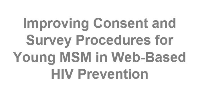Use of Videos Improves Informed Consent Comprehension in Web-Based Surveys Among Internet-Using Men Who Have Sex With Men: A Randomized Controlled Trial
ABSTRACT
Background: Web-based surveys are increasingly used to capture data essential for human immunodeficiency virus (HIV) prevention research. However, there are challenges in ensuring the informed consent of Web-based research participants.
Objective: The aim of our study was to develop and assess the efficacy of alternative methods of administering informed consent in Web-based HIV research with men who have sex with men (MSM).
Methods: From July to September 2014, paid advertisements on Facebook were used to recruit adult MSM living in the United States for a Web-based survey about risk and preventive behaviors. Participants were randomized to one of the 4 methods of delivering informed consent: a professionally produced video, a study staff-produced video, a frequently asked questions (FAQs) text page, and a standard informed consent text page. Following the behavior survey, participants answered 15 questions about comprehension of consent information. Correct responses to each question were given a score of 1, for a total possible scale score of 15. General linear regression and post-hoc Tukey comparisons were used to assess difference (P<.001) in mean consent comprehension scores. A mediation analysis was used to examine the relationship between time spent on consent page and consent comprehension.
Results: Of the 665 MSM participants who completed the comprehension questions, 24.2% (161/665) received the standard consent, 27.1% (180/665) received the FAQ consent, 26.8% (178/665) received the professional consent video, and 22.0% (146/665) received the staff video. The overall average consent comprehension score was 6.28 (SD=2.89). The average consent comprehension score differed significantly across consent type (P<.001), age (P=.04), race or ethnicity (P<.001), and highest level of education (P=.001). Compared with those who received the standard consent, comprehension was significantly higher for participants who received the professional video consent (score increase=1.79; 95% CI 1.02-2.55) and participants who received the staff video consent (score increase=1.79; 95% CI 0.99-2.59). There was no significant difference in comprehension for those who received the FAQ consent. Participants spent more time on the 2 video consents (staff video median time=117 seconds; professional video median time=115 seconds) than the FAQ (median=21 seconds) and standard consents (median=37 seconds). Mediation analysis showed that though time spent on the consent page was partially responsible for some of the differences in comprehension, the direct effects of the professional video (score increase=0.93; 95% CI 0.39-1.48) and the staff-produced video (score increase=0.99; 95% CI 0.42-1.56) were still significant.
Conclusions: Video-based consent methods improve consent comprehension of MSM participating in a Web-based HIV behavioral survey. This effect may be partially mediated through increased time spent reviewing the consent material; however, the video consent may still be superior to standard consent in improving participant comprehension of key study facts.

